With Ceres coming alive in the latest Dawn images, why not step outside and see it with your own eyes? We also look at the history of its discovery and suggest a way to honor its discoverer, Giuseppe Piazzi.
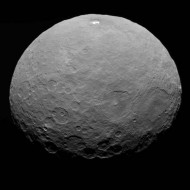
NASA/JPL-Caltech/UCLA/MPS/DLR/IDA
With the Dawn spacecraft now spiraling down to its third and closest-yet science orbit around Ceres, what better time to see this small, unique world with your own eyes? As amateur astronomers, it's a thrill to behold an object of such intense scrutiny from our own backyards. That's even more the case when spectacular images are available to feed our imaginations, turning a pinprick of light into a rumpled sphere overrun with icy craters and vaporous white spots.
Ceres is only 16 minutes away as light flies, or 182.3 million miles from Earth, and shines at magnitude 7.6. It was a tad closer and brighter in late July, but it also rose at a less convenient hour.
In mid-August, the dwarf planet comes into view not long after nightfall. With one caveat. From mid-northern latitudes, it's rather low in the southern sky. Still, if I can see it from northern Minnesota in binoculars, chances are, you can, too.
The Moon steps away from the evening sky this week, making for ideal viewing conditions. To observe Ceres, find a location with an open view to the south. My southern sky's far from ideal, but a gap in the tree line lets me sample celestial objects as far south as –35° declination for up to a half hour. Ceres will arc slowly westward in eastern Sagittarius near the Capricornus border the next two months fading a bit to magnitude 8.0 by late August.
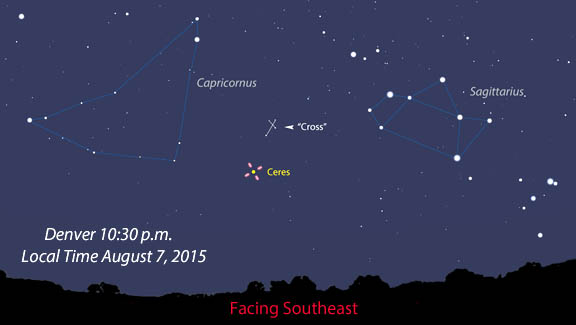
Source: Stellarium
The maps will help you get there. Ceres looks exactly like a star in 8×40 or similar binoculars. As you watch evening to evening, you'll see the dwarf planet amble west in retrograde motion, much like the other outer planets do around the time of their opposition.
Looks like we've got luck on our side the next few days as Ceres pairs up with a slightly fainter 7.7-magnitude star. The chance encounter provides an opportunity to easily spot Ceres' westward journey — watch them separate in the coming nights.
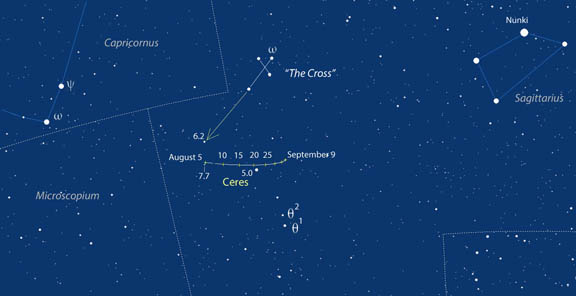
Source: Chris Marriott's SkyMap
The Discovery of Ceres
Giuseppe Piazzi discovered Ceres quite by accident on the first evening of the 19th century (January 1, 1801) while making stellar position measurement from his observatory in Palermo, Italy. Unbeknown to him at the time, a group of 24 astronomers headed up by Baron Franz Xaver von Zach, a German-Hungarian astronomer, were preparing to make a systematic search for a hypothetical "missing planet" predicted by the Titius-Bode law between Mars and Jupiter. Fittingly, they named their group the Himmels Polizei (Celestial Police).

Public Domain
Despite Piazzi's respected reputation, he had not been invited to become a member. No matter. That night around 8 p.m. he spotted a tiny new "star" in the "shoulder of Taurus" (below the Pleiades near the border with Aries) and announced it to the press the same day as a comet.
Piazzi kept track of the object through the the 23rd, observing it on a total of 13 nights. The more he looked, the more convinced he became it might be something more than a comet. Here's an excerpt from a letter Piazzi sent to astronomer Barnaba Oriani in 1801, sharing his observations:
"I have announced this star as a comet, but since it shows no nebulosity, and moreover, since it had a slow and rather uniform motion, I surmise that it could be something better than a comet."
Piazzi's observation echoes that of William Herschel just 20 years earlier when Herschel chanced across what he thought at first was a new comet, but turned out to be Uranus, the first new planet discovered since antiquity.
By the time Piazzi's data reached other astronomers in the spring of 1801, Ceres was near conjunction and too close to the Sun to observe. Astronomers worked to create a set of ephemerides they could use to track it down when it reappeared in the morning sky that summer. Unfortunately, Piazzi had observed it along too short of an arc (just 3°) and computing an accurate orbit wasn't possible.
By August, astronomers were getting desperate with some starting to wonder if the new planet even existed. Enter 24-year-old mathematician Carl Friedrich Gauss. He took it the orbit problem to heart and wrestled an accurate solution in a little more than a month. Using Gauss's new ephemerides, von Zach finally spotted Ceres on December 7, 1802 . . . and the rest is history. For more fascinating reading on the discovery of Ceres, click here.
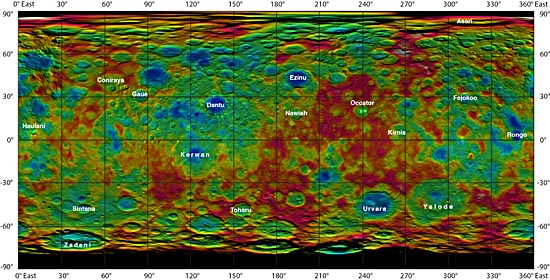
NASA / JPL / UCLA / MPS / DLR / IDA
Given Piazzi's wonderful discovery, you might expect to see his name on a large crater or other prominent feature on the dwarf planet. Yet if you peruse a recent map with formally approved names, he's nowhere to be found!
Maybe the IAU Working Group for Planetary System Nomenclature, responsible for the naming of features on solar-system bodies, has a special spot in mind, but I wonder. The group has approved two themes for use on Ceres — gods and goddesses of agriculture and vegetation from world mythology for craters and names of agricultural festivals for other features.
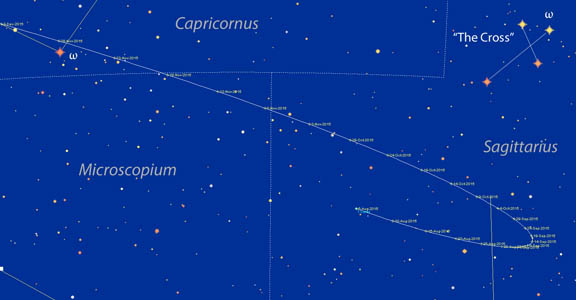
Source: Chris Marriott's SkyMap
Hmmm. That doesn't seem to leave room for Giuseppe unless the group allows exceptions similar to to Venus's Maxwell Montes (after Scottish physicist James Clerk Maxwell), the only male presence among a myriad of mythological goddesses. It, along with Alpha and Beta Regio, were first seen in Arecibo radar images in the 1960s before the naming convention was adopted.
Sure, you'll find a Piazzi crater on the Moon and even asteroid 1000 Piazzia, but there's also a Tombaugh crater on Mars and the asteroid 1604 Tombaugh, named for Pluto's discoverer. His name now graces (pending approval) the icy plains of Pluto's Tombaugh Regio.
It only seems right to honor Ceres' discover with a prominent feature on the dwarf planet itself. How about those bright, white spots or the 3-mile-high pyramid mountain? I think you'd agree that Piazzi's magnificent orb not only deserves but a look with your own eyes but his name, too.
Read all about Dawn's arrival at Ceres and what it will do there in the April 2015 issue of Sky & Telescope.
 8
8








Comments
Anthony Barreiro
August 5, 2015 at 5:53 pm
Thanks very much Bob. I completely agree that Piazzi should be honored with a named feature on the surface of the minor planet he discovered.
I've tried looking for Ceres a few times in the past couple of months, but even from latitude 37 degrees north, she is too low in the glow of light pollution to be an easy find, and I haven't made a definite observation yet this year. Your finder charts look to be very helpful. I wish there were a black-on-white version I could print out to use with my binoculars.
You must be logged in to post a comment.
Bob KingPost Author
August 7, 2015 at 12:02 am
Hi Anthony,
I thought about going black and white, but because the asteroid and star field didn't go deep (past mag. 8) I stayed with the "normal" look. Have you tried printing out the higher res version?
You must be logged in to post a comment.
Anthony Barreiro
August 7, 2015 at 1:11 pm
Solid color images use a lot of ink in my inkjet printer, and the pages come out damp and blurry. It's not a huge problem, I can use my star atlas and just remember where Ceres will be.
Southern Sagittarius is impossible from my home in the city, but next week I'll be camping on Mount Diablo for the Perseids, so I'll have another look.
Thanks!
You must be logged in to post a comment.
Joe Stieber
August 6, 2015 at 7:03 am
The "Cross" asterism has a more traditional name, the "Terebellum." I too used it to guide my search for nearby Ceres last night (August 5/6, 2015) as part of an effort to see all the planets, and a couple of asteroids, in a single night. Using 16x70 binoculars, Ceres wasn't difficult to see just above the described magnitude 7.7 star, HD 192652. When spotted around midnight, Ceres was about 19 degrees altitude from my light-polluted suburban New Jersey backyard at 40 degrees north latitude (8 miles from center-city Philadelphia). Magnitude 7.1 Vesta was not difficult with the 16x70s either, hopping over from Uranus roughly 11 degrees away.
You must be logged in to post a comment.
Anthony Barreiro
August 6, 2015 at 2:44 pm
Joe, were you able to see Mercury and Jupiter? And was Pluto on your list?
You must be logged in to post a comment.
Joe Stieber
August 7, 2015 at 9:00 am
Anthony -- Yes, I picked up Mercury a few minutes after sunset, while the disc of Jupiter and the slim crescent of Venus were spotted just before sunset (8:09 pm EDT from my location), all with the 16x70s. It's amazing how quickly Venus has dropped in the evening sky as it heads towards inferior conjunction on August 15th. Saturn, of course, was easy with unaided eyes when it got a little darker. The rings were not resolved in the binoculars, but the elongated shape was clearly evident. Around midnight, I spotted Ceres, then Neptune and Uranus. The latter is pretty bright in the 16x70s, and now that the moon is moving out of the picture, I will be looking for it with unaided eyes. Around 1 am, I used Uranus as a starting point to hop over to Vesta. Finally, at 5 am (about an hour before sunrise), I picked up Mars in the morning twilight at a couple degrees altitude. Since this was a binocular effort (only Saturn was visible naked eye), I did not attempt Pluto, which I had already spotted a couple of times in mid-July with my 12.5-inch scope. Note: For the sightings near sunset and sunrise, I travelled to nearby fields to get a suitably low horizon.
You must be logged in to post a comment.
Anthony Barreiro
August 7, 2015 at 1:14 pm
Congratulations! I've enjoyed playing solar system bingo (my name for trying to see all the planets and bright asteroids in a single night), but never with so many planets so close to the Sun.
Watching Venus drop toward the Sun has been quite dramatic!
You must be logged in to post a comment.
Bob KingPost Author
August 7, 2015 at 12:03 am
Hi Joe,
Thanks for mentioning the traditional name "Terebellum". I wasn't familiar with the term.
You must be logged in to post a comment.
You must be logged in to post a comment.